Of course the biggest benefit of my career is the guilt-free indulgence of buying all the fabric I need (or want!).
Each new project requires a different “palette” of fabrics. Wherever I travel, a visit to the local fabric store is part of the itinerary. This in turn leads to stacks, piles, leaning towers, bales, barrels, truckloads, torrents, and floods of fabrics—or so my husband, Tom, claims.
Okay, I have a lot of fabric. In my defense, if I look at a bolt of fabric in a store, I can probably tell you whether I have it already. However, I may not be able to lay my hands on it without a search. The trick, then, is to organize my fabric so that when I need something I can find it (eventually).
How I organize and store my fabric is of interest to my students. Many of them have a lot of fabric themselves, though where they may own yards of a relatively few fabrics, I own small chunks of (literally) thousands fabrics. That can be a major difference between traditional quilting and fabric collage quilting. A traditional quilt may employ a handful of different fabrics. In my quilts, I always lose track of how many I use.
When I was done piecing the 20-foot salt-water crocodile, “Crocodylus Smylus,” I had drifts of fabric mounded up in front of my pinning board. While I was folding them to put away I counted close to 300 different fabrics. When making a much smaller piece, “Polka Dodo,” I used over 100 different fabrics—every one of them with polka dots!
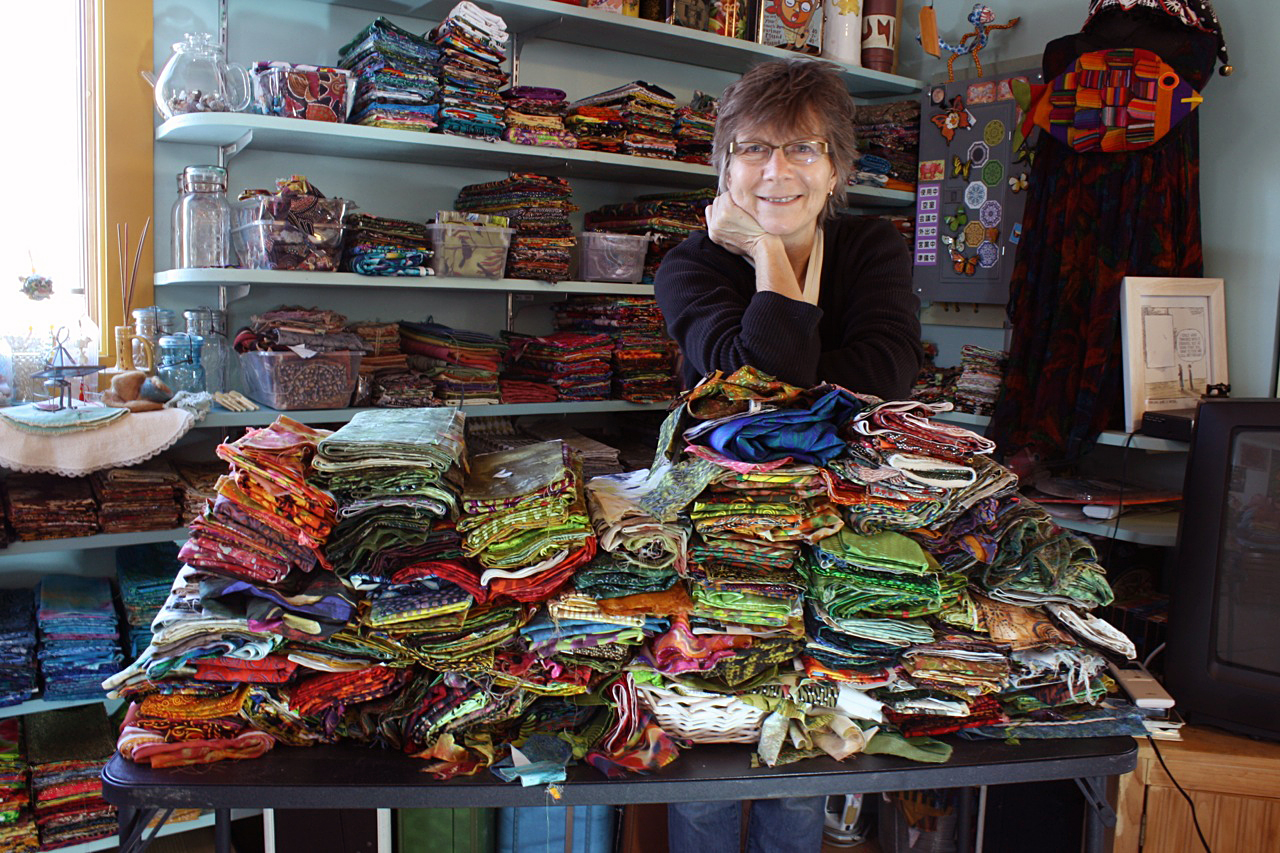
There are obvious ways to organize fabric:
- Color (reds, blues, greens)
- Pattern (stripes, animal prints)
- Fiber content (cottons, silks, synthetics, sheers)
- Novelty fabrics (Christmas, Aboriginal)
Then there are less obvious, some known only to me, ways:
- Fabrics I collected on a particular trip (New Zealand, Yellowknife)
- Fabrics by a particular designer (Kaffe Fassett, Jane Sassaman)
- Future quilts I have in mind (Daisy, Hassan, and Max)
In order to categorize a particular fabric, I identify its most dominant characteristic. When I look at that fabric, what’s the first thing I think of? The fact that it’s a particular color may not be most important to me. In fact, I may have several fabrics of different colors but with the same pattern, all of which I group together in my head. If they coalesce in my brain, they probably ought to go together on the shelf.
So, in the winter of 2013 I built a new studio. Or rather, we had it built and Tom did a lot of the work himself. (See a future blog for that story.) This gave me the opportunity to set up my work space exactly how I would like it. I knew I would need a lot of shelf space, so Tom built me a whole wall of shelves.
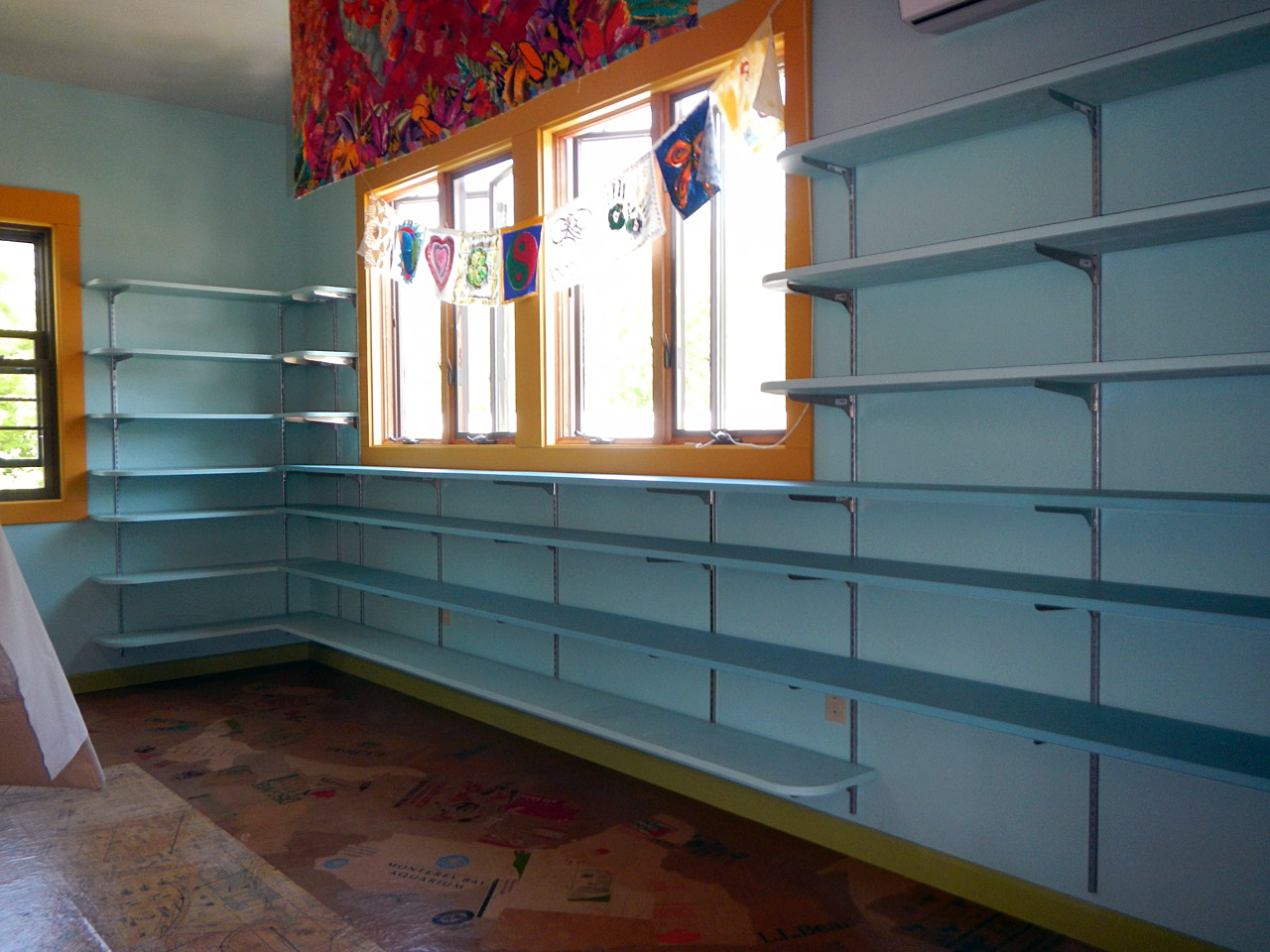
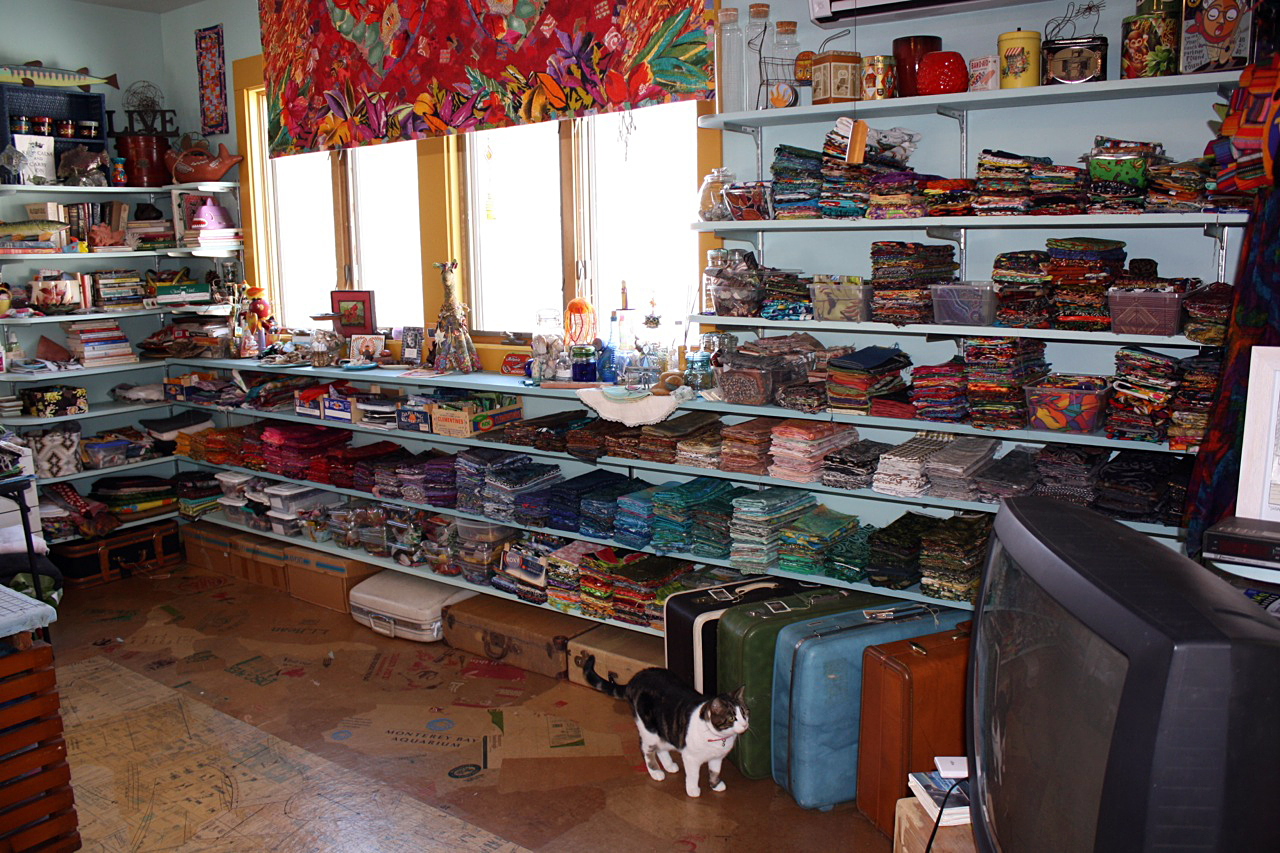
As you can see, the shelving fits a lot of fabric. Folded fabric. The larger pieces of fabric, up to a couple yards each. Most I organize by color and shades of color. For instance, there’s an orange pile, with red-orange next to that, followed by reds with a maroon cast, then magenta and pinks, purples, cool blues… you get the picture. It’s a rainbow. Blacks, browns, tan, beige, whites are in their own sequence on another shelf. With my palette, these don’t require as much space.
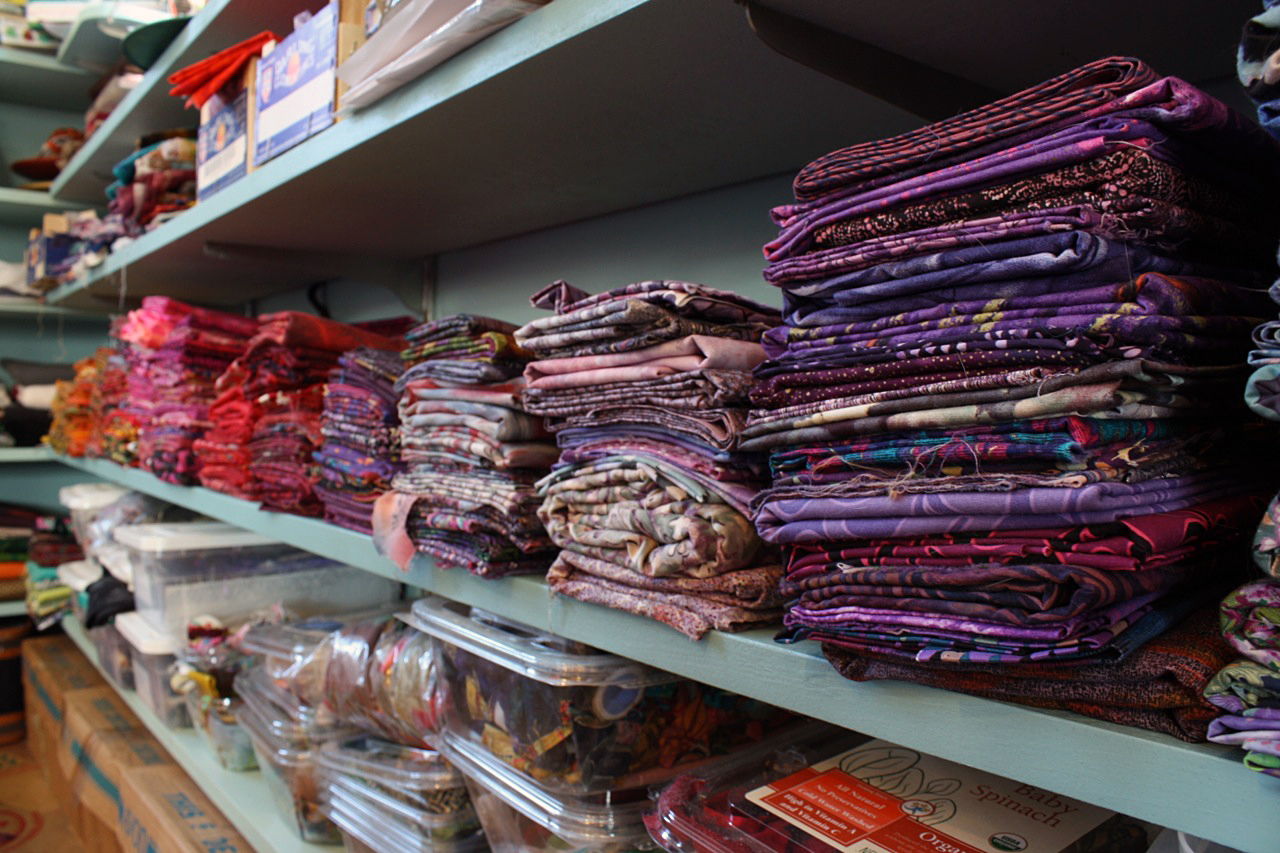
Certain chunks of fabric are big enough to fold, but would get lost in the shelves. These I store in clementine orange crates. You’ve probably seen them in the grocery store.
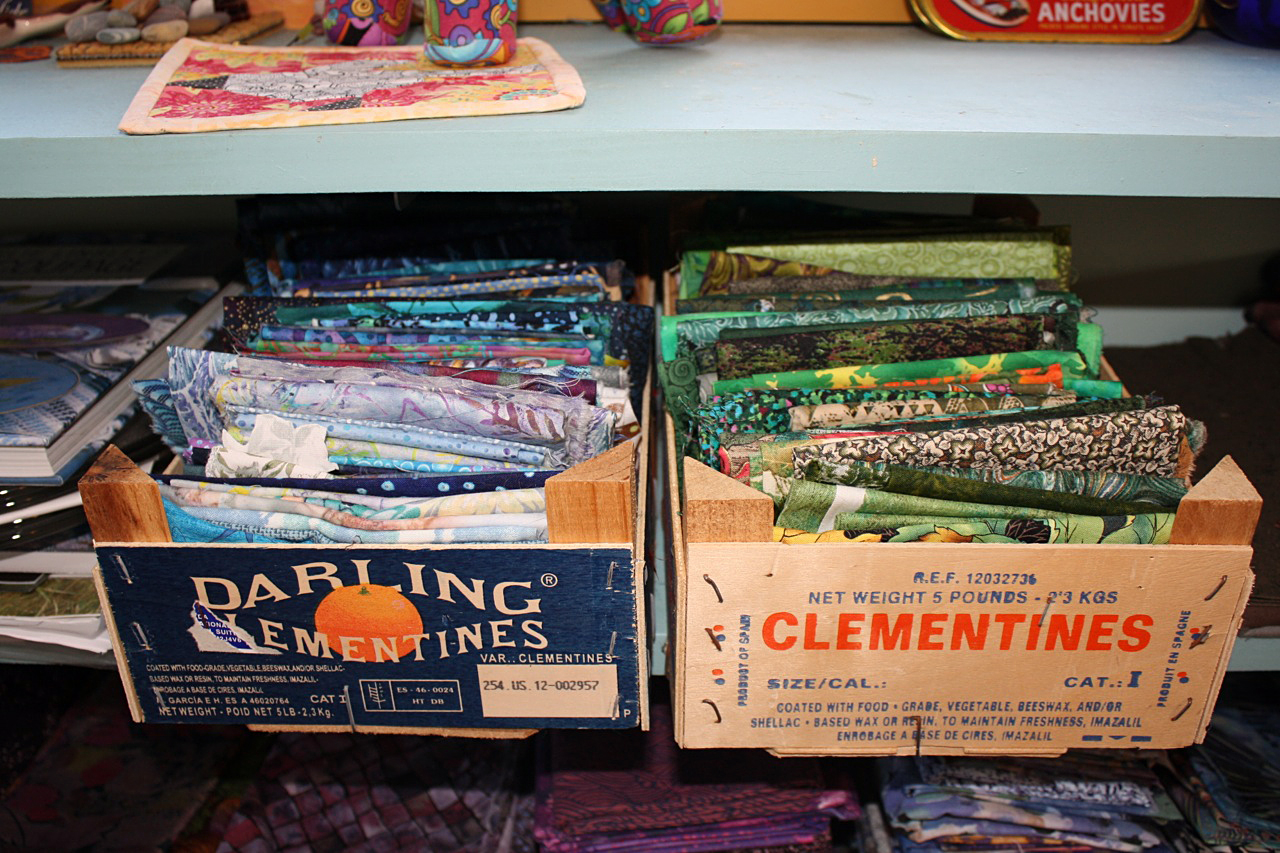
But there are even smaller pieces. As I cut up my fabric, I end up with odd, often quite small scraps. What do I do with all those pieces that other quilters would probably throw away? I have a couple of solutions.
Do you buy lettuce in plastic containers? Those things are great! They’re just the right size, they’re clear so you know what’s in them, and I feel good re-using them instead of discarding them, even if it’s off to be recycled. It’s easy to organize scraps either grocery-oriented way, by color or whatever criteria makes sense.
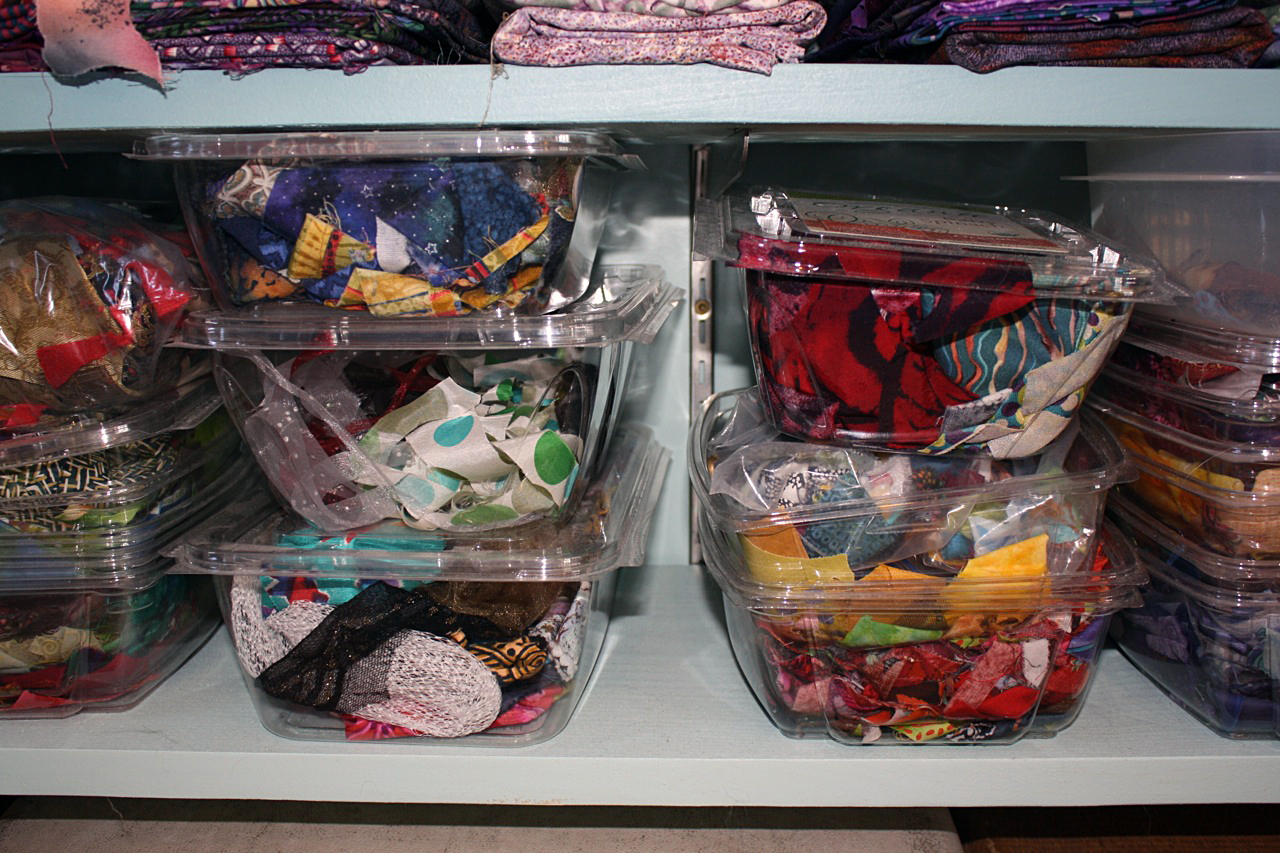
Sometimes the scraps build up, however, and drastic steps are necessary to find them a home. That’s where the suitcases come in. I collect those nostalgic, hard-cover suitcases. So far I have more than a dozen suitcases full of scraps (my husband made me stop counting), most bits no bigger than the palm of your hand.
The scraps I save are a great inspiration to me. In fact, I’ve created entire quilts out of scraps. For the quilt of my son Sam, “Samuelsaurus Rex,” I used the bits and pieces I had gathered just as they were, with almost no cutting whatsoever, using value as much as color to create a kinetic likeness of my little dinosaur lover.
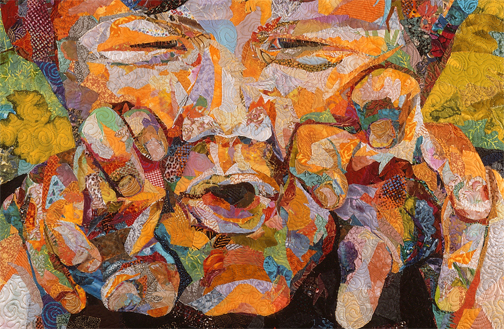
Whether on shelves, in transparent tubs, or tossed into a suiltcase, I need to be able to see it, touch it, compare it to others, hold it up to my quilts, or set it aside only to pick it up again later.
However fabric is stored it has to be accessible. I, and probably you since you made it to the end of this post, will always be attracted to fabric. It’s the fuel of our creations, or possibly just the way we decorate our shelves. But, if we’re lucky, we’ll re-discover that perfect piece at the perfect time. How else will fabric work its inspirational magic?
Do you have a good storage idea to add? Leave it in the comment section below!
For an updated version of this post, visit this link.

I really appreciated your article. I find all your work inspiring. Thank you. Sue.
Sent from my iPad
>
Do you rent out your hubby,, ?
I enjoy your posts very much and appreciate you’re sharing so much valuable information. Have you done any articles on the construction process you use – I would be very fascinated to see that. Thank you again!
I assume you mean quilt construction, not building construction. 🙂 See my first blog on “Crocodylus Smylus,” which includes an overview of my fabric collage process.
Yes. Raw edges and glued. Secured by quilting. I often piece the background, but that too is glued. The whole thing is one piece in the end.
I don’t have all that much fabric, (well, sorta), but when I see it laying helter skelter, I sometimes think it would be easier to design a quilt around it, than to find a home for it. lol
Carolyn,
mylady@nbnet.nb.ca
I love the open shelves so you can see what you have. I also like the small clear plastic lettuce boxes for really small pieces. Great ideas. I store my fabric in a closed dark cupboard…have to rethink that. I think I will remove all my books from my book shelves and put the fabric there. Or maybe remove the doors from the cupboard! Hmmmm….
Do you ever find that the light from your lovely windows fades the folded fabrics on the open shelves? I have a studio full of windows and have had to use cabinets for my stash. I also use fusibles on my fabric, so I save my prefused scraps in small bins by color. Love your lettuce container idea. I will have to use it.
Something else I forgot to say, all my studio windows are Low-E. Not that it filters out all UV light, but it’s a start. Also, the shelf directly under the window shades the shelves below. Trying to achieve a balance between fading risk and the benefit of natural light for working. As time passes, I’m keeping an eye on those outer folds of my fabric. So far, so good.
You know, that’s a concern for sure. I made sure my shelves receive very little direct sunlight. The windows you see face north and there are no south-facing windows nearby.
You’re welcome!
As Nancy pointed out below, make sure your shelves aren’t in direct sunlight. Many fabrics are susceptible to fading.
even your fabric stash is inspiring..
The china cabnet looks great with fabric in it. Getting less sentimental all the time, only the useful favorite crystal items left on the top shelf space. Then there is the other rooms!
Studio looks great with the shelves.!!
When I visited they were not up..My first workshop with you I used large zip lock bags to sort fabric colour ,size etc..I have various big bags filled with many zip lock bags stored under my cutting table..
I use clear square rubbermaids for theme fabrics as well,hawaiian,cat,novelty etc..I have sections sorted by theme,animal print ,ombre,batik,hand dyes,designers,Alexander Henry,Kaffe,Tula,etc..
I use Polar Notions to store anything over a yard..it,s scary to see how much yardage I have kicking around…They sit on shelves like books of fabric..inspiring to glance at..fabric happiness.
I use clear plastic ice buckets for scraps that are of significant size,sorted by designer,or left overs from a finished quilt,baskets are handy as well and I keep all my scraps by size.
Then the sub straits..which own shelves and are bolts..laminated,velveteen, ..for my clothing,bag making etc..
Jars,tubs ofscissors, ribbon,trims,buttons,zippers..thread stored in wired shelves with removable drawers..organized by type..
Sounds a bit OCD….!!!!
The most important item in the entire room is the treat jar for my cats who keep me company and are rewarded or distracted when I need them to move off the project that I am working on!
Really enjoying your blog Susan!Hi to your mom and family!
Christina
Great article. It is nice to see other people organization systems. The glare of the sun light will also make the fabrics fade over time.
Susan, I feel as if I’ve just taken a great class every time I read one of your posts. The tips, information and perspective you share based on your experience is inspiring to say the least. I’m beginning to look at color, value and fabric in a new way. And I have a LOT of fabric to look at in a new way, so thank you for giving me an expanded perspective that opens up so many exciting possibilities in quilt construction and design. Keep up the wonderful posts. I’m learning so much from you, and am even more motivated to make time to spend in my studio!
Thanks for this great post!
My hint for organizing is to purchase a sheet of plexiglass from the hardware store. It can be cut with a mat knife to the exact size of your storage space. Then you can fold your fabric over the plexiglass to fit neatly into the space. BTW, I visited your crocodile in Cedarburg WI. Your crocodile was stunning and the show was great!
Thank you. I did look through that – very interesting. Are the collage pieces raw edges and glued? Then secured by your quilting? Your back appears to be pieced so then the object is placed and appliqued? I so wish I could see one in person!
Thank you for sharing your organization tips! I pride myself in saving boxes and bins of all types, but I never thought of keeping the clementine boxes OR the plastic salad containers. Genius! Off topic, I wonder if you might be persuaded to use a larger font or black lettering for your posts. I find them a little hard to read. Might just be me, of course…
Leslie, if you hold the controll key and hit the plus sign + will make the words bigger
Thanks for your tips! I wrap my fabrics on comic book boards that are acid-free so it stands up on my shelves. Anything that is 1 yard or larger goes into the boards. If it is too big (more than 4 yards or so), to fit well on the boards, it is folded and stored in a dresser drawer. I wrap anything 1/2 yard to less than a yard on a comic book board that is cut in half and store them in a clear 3-drawer unit. Fat quarters are also stored in these units, without a board in them. For my scraps, anything that is less than 2 1/2″ is donated to a lady in my quilt guild who uses them to make beds for dogs in shelters. Anything 2 1/2″ up to fat quarter size is stored in fabric bins in a 9-cubby shelving unit. I have bins of every color, so I know what color of scraps is in each bin. Now if I only had room for more shelves! 😉
Donna
Sounds very well organized!
You aren’t to first to make that comment. I’ll have my husband work on that!
I go through my fabric stash yearly and do manage to remove (the horror) older fabrics I haven’t used in years and donate them to local non-profits. That way there is more room – especially for batiks!
I have been collecting small pieces of fabric for over a year because I knew someday I would be taking a class with you-it was just a question of where. I have a tower of 6 or 7, 4x8x2.5 clear plastic containers that snap together with an attached lid. Easy to sort in rainbow order and they hold a lot of pieces. Can’t wait for your class in March at Asilimar!
See you there!
I use plastic totes, and one rolling three drawer storage tower. I keep my Batik fabric separate from all others, and my Japanese Taupe fabrics separate too. I usually store fabric by project groupings such as these can make a purse…these can make pillows…these are large backing fabrics….these colors of fat quarters, together would make a quilt top…etc…
I love your work and it really inspires me!
Love your blog…all input greatly appreciated!
Love your blog…all input greatly appreciated!
Not only do we get fabulous quilting advice but also some computer use tips! Thanks for the tip on font size.!
Not only do we get fabulous quilting advice but also some computer use tips! Thanks for the tip on font size.!
I’m totally stealing the cat treat idea for my new studio! The cats think it’s their room, full of shelves and cubbies… ;o)
Thank you for pointing me to this post, Susan. My system is not too far off of yours in terms of organizing by color and then value, but I have mine stored in labeled 8-drawer towers. Unfortunately, the individual drawers are only 2 1/2″ deep, so I need lots of towers! I think I’ll start collecting those lettuce containers for the littler pieces. I inherited a lot of traditional small-print fabrics from my mother (along with some gorgeous large-print florals that you just don’t see anymore). I am going to pull those small print and solids out and store them separately. Happy Quilting!
I organize my fabric in clear plastic shoe bins. I spray paint the tops. If they are prints then I try and make the tops to match by making a stencil out of thin cardboard. For example if I have gingham material I will make a stencil lay it on the lid and spray paint the pattern on to the lid. If it’s polkadot then I make a circle stencil. If it’s flowers I use my old stencils lay it on the lid, tape it and spray pain it. It’s an expensive way to do it but because most of my sewing storage is in an outside shed I have put my fabric in bins.
I have a guest room closet I converted into sewing storage and use things like pencil boxes labeled of course to store things like needles, bobbins,etc. I also have acquired several metal drawers and small individual plastic drawers that quys use to store nails, screws and other small pieces they used when making things.
My biggest problem is organizing by color.
I love to hand quilt my quilts but organizing my fabric by color is a real pain in the neck.
Do I start out with white and go that way or black, gray , white, cream, tan etc.
In other words what order do I put my blacks white, grays tans, browns , cream, reds, blue. Purples, yellow,orange and all the other colors in between.
Hi Joan! Basically, whatever sort of organization works for your mind is good! For me, I have a “rainbow” color sequence of fabric stacked along my shelves—orange to red to purple to blue to green to yellow. The “neutrals” like tan to brown to black to grey to white, are on another shelf. It’s not perfect, but it gives some semblance of order! Hope that gives you some ideas! —Susan